 |
  Home | Contact | Site Map |

| Top Destinations |
|
You are here Home » Top Destinations » Himachal Pradesh
Honeymoon in Himachal Pradesh India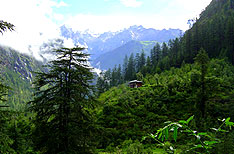 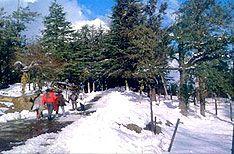 About Himachal Pradesh Nestled in the Himalayas, the world's mightiest mountain ranges, Himachal Pradesh is blessed with some of the most spectacular and beautiful, landscape anywhere, it is travellers paradise, - mighty snow peaks, deep gorges, lush green valleys, misty woods, fast flowing rivers, enchanting lakes and flower filled meadows. Its high mountains and valleys are linked by winding roads and high passes. While the picturesque valleys of Kullu and Kangra are a riot of colours. In marked contrast the stark and barren terrain of Lahaul & Spiti have stunning lunar and scape like beauty. Life here moves at a gentle pace far from the mad rush of the cities. Himachalis lead a simple and quite life, tending their orchards, fields and flocks. Keeping alive their rich art and culture. They remain interested in the annual rounds of fairs and festivals, full of music, song and dance. For the visitor there are superb locations for relaxing and sight seeing. There are also great opportunities for trekking, mountaineering, fishing, river rafting, skiing and paragliding. NATIONAL PARKS AND SANCTUATRIESThe Great Himalayan National ParkThe Himalayas have been a source of awe and inspiration for millennia to countless individuals. They are the largest, tallest and geologically youngest mountains on our planet. In India, they are the Dehvbumi--the home of the gods. The Himalaya are also one of the most fragile mountain regions of the world and hold an enormous repository of biological diversity which is increasingly under pressure from human activities. The unique ecological aspects of the Western Himalaya led to the creation of the Great Himalayan National Park (GHNP) in the Kullu district of India's mountain state of Himachal Pradesh. These features include biodiversity, sparse human populations, inaccessibility, little tourism, and a local economy based on traditional livelihoods. Pin Valley National ParkDeclared a National Park in 1987, Pin Valley is located in the cold desert region of the Spiti valley. With its snow laden unexplored higher reaches and slopes, the Park forms a natural habitat for a number of endangered animals including the Snow Leopard and Siberian Ibex. Spreading south of Dhankar in the Spiti district near the Tibetan border, the Park marks the Lahaul and Spiti divisions of the State. The elevation of the Park ranges from about 3,500 mts near Ka Dogri to more than 6,000 mts at its highest point. Because of its high altitude and extreme temperatures, the vegetation in thearea is scant and mostly dominated by alpine trees, patches of Himalayan cedar and smatterings of several medicinal plants. In summer, flowers decorate the valley with startling hues. Along with animals, rare birds like the Himalayan Snowcock, Chukor, Snow Partridge and the Tibet Snow Finch also flourish in the area. Steeped in history, the influence of Tibetan culture is prevalent in the surrounding areas of the Park, visible in the Buddhist lamas, shrines, monasteries and culture of its residents. CULTUREAbout 90% of the population of Himachal Pradesh is Hindus. There main communities are Brahmins, Rajputs, Kannets, Rathis and Kolis. The tribal population of the state comprise of the Gaddis, Kinnars, Gujjars, Pangawals and Lahaulis. The Gaddis are the traditional shepherds who migrate from the alpine pastures to the lower regions during the winters. The Kinnars are the inhabitants of the Kinnaur region and practiced polyandry and polygamy. The Gujjars are nomads who rear buffalo herds. The Pangawals of the Pangi region of the Chamba district are both low and high caste Hindus. The Lahaulis of Lahaul and Spiti region are mainly Buddhists. FESTIVALSFairs and festivals are an integral part of the Indian way of life. The colorful state of Himachal Pradesh has many fairs and festivals to celebrate throughout the year. The National Snow Statue Competition at Kufri near Shimla begins in the New Year. The ice-skating in Shimla begins around this time. The bonfires of Lohri, a festival to mark the sowing of the Rabi crop light up the night sky on January 13 every year. The skiing competitions are held at Solang Nullah in Manali in the month of February. A fair in the memory of the sage Baba Barbhag Singh is held at around the same time at Una. It is believed that the Baba had magical powers, which were used towards altruistic ends. The little kites dapple the horizon with their color during the Basant Panchami, the arrival of the spring. Shivratri or the festival to celebrate the marriage of Shiva in March signifies ritual gaiety at the famous Baijnath shrine. The cattle fair is held at Nalwari in Bilaspur. Chait Durga Asthami is celebrated in the Shakti shrines at Hathkoti, Chitpurni, Jwalamukhi and Vajreshwari. Color and fun mix on Holi, the festival of colors at the Gurudwara at Paonta Sahib in Sirmaur. In April, Chhat celebrations are held in Kullu and Chamba. Paonta Sahib welcomes Hindu and Sikh devotees on Baisakhi. The Navratri begins this month. Fairs are held in Chamba, Bilaspur, Kangra and Rohru village in Shimla district. A colorful celebration takes place around the old temple of Hidimba at Kullu, Doongri in May. Banjar Mela in Kullu also starts in the second half of the month. Paragliding season begin in Bir in Kangra. A variety of cultural events are held at Shimla, Dharamshala and Dalhousie during the month of June. The Prashar Fair is held in Mandi off the Prashar Lake. The Red Cross Fair in Shimla is a big draw with the tourists. The Himachal Folk Costumes Programme and the Flower Show in Shimla attracts active participation of the locals. Lahaul celebrates a unique festival called Cheeshu. Haryali is celebrated in Kangra and Sirmaur and Shravan Sankranti in Nahan in the month of July. Buffalo fights are the highlight of the Sari fair held at Arki in the month of August. The Lahaul Festival is held near Keylong. Kaza's Ladarcha Fair is a commercial fair held on the old trade routes to Tibet and Afghanistan. The Manimahesh Yatra starts in the district of Chamba. The famous fair of Naina Devi in Bilaspur also takes place during August. In the first week of September, Fullaich (Phulech) take place in Kinnaur while Kangra plays host to Sair. Chamba is the location for the colorful fair of Rath-Rathni. Dussehra is one of the most sacred festivals of the Hindu religion and is celebrated in October. The much talked about Dussehra celebrations start in Kullu with Navratri. The Pong Dam is the site of water sports championship held in the same month. Diwali is celebrated throughout the state. On the banks of Sutlej, the Lavi fair is celebrated for three days. At Sirmaur, idols of Parasuram are immersed in the waters of Renuka Lake. Shimla has the tradition of celebrating Christmas since the days of the British Rule. To take part in the festivities, people come from far off places. The International Himalayan festival is held in Dharamshala in the second week of December. DANCE AND MUSICThe dance and music of the state is mainly religion-oriented where gods are invoked during the festivals by singing and dancing. This practice has continued since ancient times. The major dance of the state are the Rakshasa (dem0on) dance, the Kayang Dance, the Bakayang dance, the Bnayangchu dance, the Jataru Kayang dance, Chohara dance, Shand and Shabu dances, Lang-dar-ma dance, Nati dance, Jhanjhar dance, Jhoor dance, Gi dance and Rasa dance. ARTS AND CRAFTSThe arts and crafts of any region are a reflection of its environment, people and traditions. So it is in Himachal. Weaving, as carving , painting,or chiselling ? are such an intrinsic part of the Himachal life! The scenic beauty of the region transfers into the creations, as it were, and the result is colourful pashminas, exquisite wooden doors, rhythmic sculptures. From the upper reaches of Lahaul and Spiti down to the lowlands of Kangra ? life and its shades are woven in, painted on, felt in soulful rhythms or celebrated with joyous abandon, carved in, engraved? whether it is the miniature paintings of Kangra, the thangka artefacts of Spiti, or the beautiful shawls of Kullu. As you move through the state, an enchanting and colourful tapestry unfolds ? the architecture, objects, shops, museums, galleries and craftsmen charm with the variety and mastermanship perfected through the ages. If you happen to be in Kangra town, walk into the narrow winding lane called Kumhar Gali, linked to the bazaar leading to the Kangra Devi temple in the heart of the town. You will find a row of double storeyed houses surrounded by large courtyards and entire families bent over potters` wheels, beating the clay or applying a coat to the finished pots. Woven CraftIt is the extreme cold winters of Himachal that necessitated wool weaving. Almost every household in Himachal owns a pit-loom and it is not unusual to find men and women spinning yarn on a spindle walking down the roads of Himachali villages. Wool is also regarded as pure and is used as a ritual cloth. The best-known woven object is the shawl, ranging from extremely fine pashmina to the coarse desar. Kullu in particular has been famous for its shawls with striking geometrical patterns and vibrant colours ? the distinctive feature being stripes running along the edges. Wood CraftHimachal is the only area in India, besides Kerala, where wood has played an important role as a structural material. The most abundant wood in Himachal`s forests is the pine and deodar, besides walnut, horse chestnut and wild black mulberry. Villages famous for woodcraft are Chamba, Chhatrarhi, Brahmaur, Koonr, Tisa (Chamba); Kalpa, Thangi, Rarang, Sapni, Batseri, Shaung, Bari and Bhaba (Kinnaur); Dungri, Banjar and Saraj (Kullu). Earliest wooden temples in Himachal date as far back as sixth century AD and are located in Brahmaur and Chhatrarhi in Chamba. Many other temples sculpted in wood lie scattered all over Himachal. Village homes too are extensively ornamented with carvings ? on doors, windows, balcony panels etc ? some exquisite examples may be found in villages as remote as Kamru, Sangla, Chitkul, villages in Kinnaur and Jagatsukh, Vashishta and villages around Manali and Kullu. The craft also translates into wooden idols of gods and goddesses in classical as well as rural styles. Utilitarian objects crafted in wood can be often found in Pahari homes ? these may include rectangular boxes to store grains or ornaments: the extent of carving indicates the social strata of its owner. Stone CraftThe Shivalik hills abound in fine sandstone, which is eminently suited for carving, and has played a vital role in perpetuating the stone carvers? craft. Numerous stone temples still dot the Himachal landscape. Kangra, Mandi, Bilaspur, Sirmaur, Chamba and Kullu have been traditional centres for stone carving. The capital towns of feudal states often had large stone temples ? the monolithic temple of Masroor, Baijnath temple in Kangra, Shiva and Devi temples at Jagatsukh, Naggar, Nirmand and elsewhere in Kullu, the numerous shrines along the banks of the river Beas in Mandi, the temples at Brahmaur, Chhatrahi, Chamba, Bilaspur and Sirmaur date from the 7th and 13th century AD. MetalcraftObjects crafted with metal fulfil religious, ritualistic and everyday needs of the people of Himachal. Even in AD 600, the courts of the Himachali kings had master craftsmen who specialised in metalware, and antique metal statuettes are a feature in many temples of the state. There are fine examples of freestanding metal statues at temple entrances in Brahmaur, Chamba and the Vajreshwari Devi temple in Kangra. Gods and goddesses also appear as mohras or in metal plaques ? which are used during processions and festivals. In fact, metalcraft in Himachal grew around temples and palaces. Repousse technique was used to create beautiful temple doors ? temples of Vajreshwari Devi, Jwalamukhi in Kangra, Bhimkali in Sarahan and Chandika Devi in Kinnaur employ this technique to perfection. Bronze figurines, particularly that of goddess Durga killing the demon Mahisha is a common sight in most households. Low settees made of silver or brass are another common ritual artefact used in homes as well as temples, besides bells, incense burners, lamps, jars, flasks, tridents, fly whisks, and canopies. JewelleryPahari jewellery is artistic and elaborate. It has the vigour and sturdiness of style that comes from nature itself. The designs are borrowed from simple motifs like seeds, flowers and leaves and developed into exquisite patterns. While different communities wear jewellery unique to their traditions, some ornaments are worn all over. These include the hemispherical boss or chak ? worn on the crown and both sides of the head. Neck ornaments are important in all districts ? from collar like hansli or small pendants called toke. The Pahari variant of the torque is a long necklace of numerous chains linked together by silver plaques. Chandanhaar is a necklace comprising five or seven rows of facetted gold beads. One of the most cherished neckpieces is a coin necklace. The choker worn here is called kach and consists of silver beads and triangular plaques. Earrings are often worn with drops or granulations, nose studs are embedded with precious and semiprecious stones and often, an ornament of pendants is strung to it. Chiri tikka is a flat piece of silver, enamelled or embedded with pearls and suspended from the centre of the forehead while several chains hang along the hairline on both sides. General Information of Himachal Pradesh LOCATIONHimachal Pradesh, in North India, is accessible by air, rail and road. Punjab on the west, Uttar Pradesh on the southeast, China on the east, Haryana on the southeast, and Jammu and Kashmir on North border the Indian state of Himachal Pradesh. It extends from the latitudes 30?22'40" North to 33?12'40" North and longitudes 75?45' 55" East to 79?04' 20" East. How to Reach By AirThere are three airports in the state of Himachal Pradesh. They are at Bhuntar, Gaggal and Jubbarhatti. The air routes connect the state with Delhi and Chandigarh. There are no international airports in Himachal Pradesh. Vayudoot services connect Jubbarhatti, 23 km from Shimla, with Kullu, Chandigarh and Delhi. Jagson Airlines has flights from Delhi to Shimla. By RailHimachal Pradesh is not very well connected by railways as it is not easy to construct railway lines in the high altitude and rugged terrain. The Pathankot-Jogindernagar line is the longest railway line connecting Punjab with Himachal Pradesh. The other railway tracks pass through Shimla, Solan and Una. Shimla is connected with Kalka by a narrow gauge railway line, which in turn is connected with the major cities in India. By RoadIt is difficult to construct and maintain new roads in the hilly areas of the state. Most of the important places of Himachal Pradesh are well connected with the roadways. Few of the roads get closed during winters and monsoon seasons due to snowfall and landslides. Regular bus services connect Shimla with Chandigarh, Kullu, Manali, Delhi, Mandi, Pathankot, Amble, Chail and Dehradun. Local taxis are the major local transport here. BEST TIME TO VISIT The climate of Himachal Pradesh, depending on the altitude, varies at different places from semi tropical to semi arctic. Winters (October to February) are very severe and heavy snowfall is recorded during this season. April to June is delightful and comfortable at the higher altitudes, though on the lower hills, this season can have more humidity than usual. July to September is the time for rainfall and the entire region becomes green and fresh with streams swelling and springs replenished. Tourist Attractions in Himachal Pradesh Shimla
Chail When Bhupinder Singh, Maharaja of Patiala,was expelled from Shimla - the `summer capital' of the British in India - he decided to create his own capital for the hot months. The little village of Chail was perfect. It lay surrounded by magnificent deodar forests, Shimla was in direct vision and most important, the hill of Chail at 2226 m was somewhat higher than British-controlled Shimla. Today the Maharaja's creation can be experienced by everyone. Whether you are on a honeymoon or in search of seclusion or wish to organise a conference and demand all facilities, Chail has it all .Then, there is good sight seeing and the possibility of some fishing and trekking. Chail also has the world's highest cricket pitch and polo ground. Manali
Kullu Kullu (1220m) was once known as "Kulanthpitha" ; ' The end of the habitable world'. Beyond rose the forbidding heights of the Greater Himalayas, and by the banks of the shining river Beas, lay the fabled 'Silver Valley'. Kullu got its first motorable access only after Independence. The long centuries of seclusion has however allowed the area to retain a considerable measure of its traditional charm. Here is the core of an intricate web of numerous valleys - each of which is a visual delight and seems more beautiful than the other. The 'Silver Valley' has nature's treasures that lie carelessly scattered as flowers on the high meadows. There is pleasure in every step you take in these enchanted valleys and in every gurgle you hear in the clear mountain streams. Rohtang Pass
Barog Barog is a cute little place immerging as a major holiday attraction to spend a day in. It used to be an important stop in the early decades of the century when the Kalka-Shimla toy train stopped here for an hour while the sahibs and memsahibs enjoyed a lavish lunch. The station, one of the prettiest on the line with its hanging baskets of pink geraniums, was named after the engineer Barog. It is famous for its 1,143m long tunnel which is the longest among the 102 on the track. The train takes about three minutes to cross this tunnel. Kufri
Dharamshala The high snow clad Dhauladhar ranges of the Himalayas form a magnificent backdrop to the hill resort of Dharamshala. This is the principal township of Kangra and overlooks the wide spread of the plains. With dense pine and deodar forests, numerous streams, cool healthy air, attractive surroundings and the nearby snowline, Dharamshala has everything for a perfect holiday. It is full of life and yet peaceful. And not surprisingly, the headquarters of His Holiness the Dalai Lama is here. Covering a wide area in the form of a twin settlement, Lower Dharamshala (1380 m) is a busy commercial center, while Upper Dharamshala (1830 m) with the suburbs of McLeodganj and Forsythganj, retains a British flavour and colonial lifestyle. The charming church of St. John in the wilderness is situated here and this is final resting place of Lord Elgin, a British Viceroy of lndia during the l9th century. There is also a large Tibetan community who have made this their home. Numerous ancient temples like Jawalamukhi, Brijeshwari and Chamunda lie on the plains below Dharamshala. Dalhousie
Palampur The Kangra valley of which Palampur (1249 m) is a major station, was the 'Trigarta' of old. It was one of the leading hill states and was once a part of the kingdom of Jalandhara. In local Parlance, the word for lots of water is 'pulum'. This is what has given Palampur its name and it is water that has given the valley so much of its character. Countless streams and brooks criss-crosses the landscape and in their intricate mesh, hold tea gardens and rice paddies. The town came into being when the tea bush was introduced in the 19th century and Palampur became a focus, for the planters. Kangra tea, with its center at Palampur, has been internationally acclaimed since then to further bless the area with remarkable natural beauty, the Dhauladhar ranges rise dramatically from the earth, just beyond Palampur. The town itself has some interesting colonial architecture and the area around is richly garnished with historical temples and forts and scores of picturesque hamlets. Chamba
Paonta Sahib Surrounded by the Sal forest and on the bank of river Yamuna the historic town of Paonta Sahib(398m) was founded by the tenth Sikh Guru Govind Singh Ji. When only sixteen years old, the guru left Anandpur Sahib and on the invitation of Raja Maidini Prakash of Sirmour, lived at this beautiful place for over four years. The historic gurudwara commemorates his stay and interestingly the waters of the Yamuna fall silently below this -which happened at the Guru's behest. The word 'Paonta' means 'Space for a foot hold'. Kangra
Khajjiar Khajjiar is a modest grass-covered meadow located in the enchanting valley of Chamba. It is an ideal getaway for picnic while traveling between Dalhousie and Chamba. The calmness of place provides a soothing effect to the tired tourists. Kinnaur
Mandi Mandi is district made out of two princely starts of Mandi and Suket. It is situated on the left bank of the river Beas at an altitude of 800 m. above the sea level. It is comparatively hotter than other hill stations of Himachal Pradesh. Mandi means a market place. At one time, there were almost 360 forts out of which only 10 are left. You can take a look at some of the 81 Hindu temples in the area. There are a couple of lakes to be visited. Mcleodganj
Mashobra At a distance of 13 km from Shimla on the Shimla-Naldhera Road is the small village of Mashobra. Mashobra is well known for bountiful apple orchards and thick forests of oak and pine trees. Mashobra is an ideal weekend getaway if you are not looking for luxury but peace and tranquility and tremendous natural beauty. ? Solan
Kushinagar Kushinagar is a popular Himachal tour destination that gives you the impression of having traveled back in time to a sleepy hamlet set in the midst of exotic nature greens. Narkanda
Sirmaur Sirmaur is the southernmost district of Himachal Pradesh. It may not enjoy the tourist attention that Chamba, Lahaul or Kullu does, nonetheless it cannot be completely erased from the itinerary. The district is noted for its attractions of pilgrimage and the legends that surround them. Lahaul and Spiti
Sarahan Sarahan was the capital of the princely state of Bushahr. The raja moved in here from Kamru in Spiti. In the 18th century the capital was shifted again, to Rampur this time. Bushahr was regarded as one of the wealthiest states in the region and was a major entrepot for trade with Tibet, Ladakh, Kashmir and Khazakistan. kasauli
Arki Arki was once the capital of the princely state of Baghal. The place witnessed the might of many ? the neighbouring states of Nalagarh and Bilaspur, the Gurkhas and the British. Rampur
|
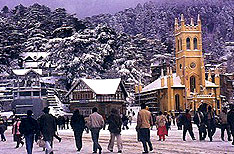 The British empire may have ceased to exist, but its echoes linger on in Shimla (2130m). As the 'summer capital' of the British in India.
The British empire may have ceased to exist, but its echoes linger on in Shimla (2130m). As the 'summer capital' of the British in India.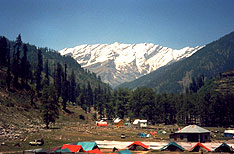 One day, Vaivasvata, tha seventh incarnation of Manu found a tiny fish in his bathing water. The fish told him to look after it with devotion for one day it would do him a great service. Vaivasvatatava cared for the fish till the day it grew so huge that he released it into the sea before departing, the fish warned Manu of an Impending deluge when the entire world would be submerged and bade him to build a sea-worthy ark. When the flood came. Vaivasvata and the Seven Sages were towed to safety by Matsya the fish-which is regarded as the first avatara of Lord Vishnu. As the waters subsided the seventh Manu's ark came to rest on a hillside and the place was named Manali (2050 m) after him. As the earth slowly dried. Here arose a place of breath taking natural beauty - which was only appropriate, for it was at Manali that life began again. And today this legendary cradle of all human kind is a prime holiday destination. There are high mountains surrounded by silent snows and deep boulder strewn gorges. There are thick forest full of cool breezes and bird song. There are fields of wild flowers, smell picturesque hamlets and fruit laden orchards.
One day, Vaivasvata, tha seventh incarnation of Manu found a tiny fish in his bathing water. The fish told him to look after it with devotion for one day it would do him a great service. Vaivasvatatava cared for the fish till the day it grew so huge that he released it into the sea before departing, the fish warned Manu of an Impending deluge when the entire world would be submerged and bade him to build a sea-worthy ark. When the flood came. Vaivasvata and the Seven Sages were towed to safety by Matsya the fish-which is regarded as the first avatara of Lord Vishnu. As the waters subsided the seventh Manu's ark came to rest on a hillside and the place was named Manali (2050 m) after him. As the earth slowly dried. Here arose a place of breath taking natural beauty - which was only appropriate, for it was at Manali that life began again. And today this legendary cradle of all human kind is a prime holiday destination. There are high mountains surrounded by silent snows and deep boulder strewn gorges. There are thick forest full of cool breezes and bird song. There are fields of wild flowers, smell picturesque hamlets and fruit laden orchards.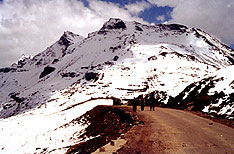 Commands an awesome height of 3978 ms and is 51 kms from Manali. Recently a new ski terrain developed here has fired the imagination of ski lovers, as it offers a new challenge to their spirit of adventure. This is the only place in the country where the skiers can indulge in their favourite sport in summer as well as autumn.
Commands an awesome height of 3978 ms and is 51 kms from Manali. Recently a new ski terrain developed here has fired the imagination of ski lovers, as it offers a new challenge to their spirit of adventure. This is the only place in the country where the skiers can indulge in their favourite sport in summer as well as autumn.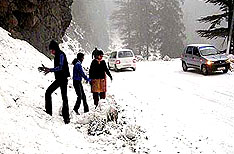 Kufri is a small hill station near Shimla. It is an important tourist place because of its closeness with Shimla. The place is known for trekking and hiking trails. There are nature parks and picnic spots at Kufri. In winters, one can indulge in the winter sports like skiing and tobogganing.
Kufri is a small hill station near Shimla. It is an important tourist place because of its closeness with Shimla. The place is known for trekking and hiking trails. There are nature parks and picnic spots at Kufri. In winters, one can indulge in the winter sports like skiing and tobogganing.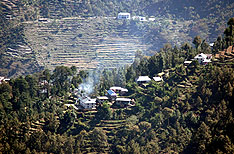 In western Himachal Pradesh, the hill station of Dalhousie is full of 'Old world' charm and holds lingering echoes of the 'Raj'. It covers an area of about 14 sq. km and is built on five hills - Kathlog, Potreyn, Tehra, Bakrota and Balun.
In western Himachal Pradesh, the hill station of Dalhousie is full of 'Old world' charm and holds lingering echoes of the 'Raj'. It covers an area of about 14 sq. km and is built on five hills - Kathlog, Potreyn, Tehra, Bakrota and Balun.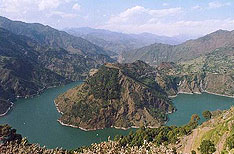 Chamba town (915 mt.) stands on the right bank of the river Ravi. As a former princely state, Chamba is one of the oldest in the country and dates back to the sixth century. It is well known for its splendid architecture and as the base for numerous excursions. Chamba is also a district headquarters.
Chamba town (915 mt.) stands on the right bank of the river Ravi. As a former princely state, Chamba is one of the oldest in the country and dates back to the sixth century. It is well known for its splendid architecture and as the base for numerous excursions. Chamba is also a district headquarters.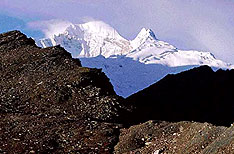 Kangra is located in the western part of the state of Himachal Pradesh, in the northern region of India. It is 18 km south of Dharamshala and is one of the prettiest valleys of Himachal with its lush green terraces & orchards, overlooking a gushing stream - the Banganga. Kangra valley starts near Mandi, runs north, then bends west and extends to Shahpur near Pathankot. The valley, sheltered by the sublime Dhauladhar range, is green and luxuriant. The area around Kangra is known for its ancient temples and picturesque surroundings and as a centre of the arts. Despite the onslaughts and political upheavels, the arts and crafts of the region continued to develop and found lyrical expressions. Crafts like the exquisitely designed shawls and miniature paintings of this region are internationally appreciated. There are several tea gardens dedicated to the production of both green and black tea. The people of the valley are well built and are known for their dedicated services to the nation as soldiers. Kangra Valley, is an ideal place for adventure and sports activities like mountaineering, trekking, rock climbing and fishing , it is this valley which witness annually Hang-gliding rally. There are many peaks between 3500 metres to 5000 metres in Dhauladhar ranges. Most of the treks are operational from May to October. Pilgrims flock to Kangra in the month of April for the Navratra celebrations, and in September-October, before the Dussehra festival, to pay their homage to Goddess Durga at the Vajreshwari (Kangra Devi) temple.
Kangra is located in the western part of the state of Himachal Pradesh, in the northern region of India. It is 18 km south of Dharamshala and is one of the prettiest valleys of Himachal with its lush green terraces & orchards, overlooking a gushing stream - the Banganga. Kangra valley starts near Mandi, runs north, then bends west and extends to Shahpur near Pathankot. The valley, sheltered by the sublime Dhauladhar range, is green and luxuriant. The area around Kangra is known for its ancient temples and picturesque surroundings and as a centre of the arts. Despite the onslaughts and political upheavels, the arts and crafts of the region continued to develop and found lyrical expressions. Crafts like the exquisitely designed shawls and miniature paintings of this region are internationally appreciated. There are several tea gardens dedicated to the production of both green and black tea. The people of the valley are well built and are known for their dedicated services to the nation as soldiers. Kangra Valley, is an ideal place for adventure and sports activities like mountaineering, trekking, rock climbing and fishing , it is this valley which witness annually Hang-gliding rally. There are many peaks between 3500 metres to 5000 metres in Dhauladhar ranges. Most of the treks are operational from May to October. Pilgrims flock to Kangra in the month of April for the Navratra celebrations, and in September-October, before the Dussehra festival, to pay their homage to Goddess Durga at the Vajreshwari (Kangra Devi) temple.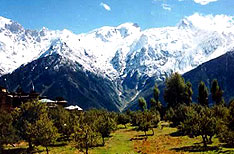 Kinnaur is a land of rich green valley, ripe orchards, vineyards, snow-covered peaks and cold desert mountains. The place is ideal for adventure sports like trekking; mountain climbing etc. the place attracts both young and old equally. The colorful dresses of the Kinnauri women and their sweet folk songs make the valley all the more bright and cheerful.
Kinnaur is a land of rich green valley, ripe orchards, vineyards, snow-covered peaks and cold desert mountains. The place is ideal for adventure sports like trekking; mountain climbing etc. the place attracts both young and old equally. The colorful dresses of the Kinnauri women and their sweet folk songs make the valley all the more bright and cheerful.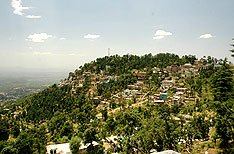 Amongst the hilly terrains of Himalayas. McLeodganj is located close to the famous Dharmshala in Himachal Pradesh. McLeodganj is the headquarters of the Tibetan government in exile, and home of the 14th Dalai Lama, Tenzin Gyatso. Camping is indeed the best way of enjoying the wonders of nature and the warmth of people. (1700 mt)9 km up from Kotwali Bazar Dharamsala is the famous town Mcleodganj often called the ?Little Lhasa?.
Amongst the hilly terrains of Himalayas. McLeodganj is located close to the famous Dharmshala in Himachal Pradesh. McLeodganj is the headquarters of the Tibetan government in exile, and home of the 14th Dalai Lama, Tenzin Gyatso. Camping is indeed the best way of enjoying the wonders of nature and the warmth of people. (1700 mt)9 km up from Kotwali Bazar Dharamsala is the famous town Mcleodganj often called the ?Little Lhasa?.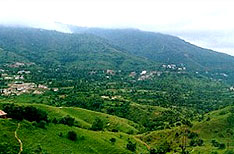 Offers you an opportunity to enter heaven. Wild apricots and walnut trees interspersed with Chir pine forests clothe the Himalayan rages all around you. Breathe in fragrant hill air and tour attractive destinations such as the Kamru Fort, Gurkha Castles, Arki Fort and Sholoni Devi Temple with Himachal Pradesh tours and Taj Mahal Tourism tour packages.
Offers you an opportunity to enter heaven. Wild apricots and walnut trees interspersed with Chir pine forests clothe the Himalayan rages all around you. Breathe in fragrant hill air and tour attractive destinations such as the Kamru Fort, Gurkha Castles, Arki Fort and Sholoni Devi Temple with Himachal Pradesh tours and Taj Mahal Tourism tour packages.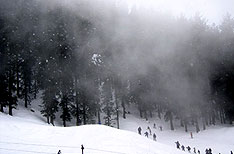 Narkanda is a spectauclar drive from Shimla, the winding road revealing some stunning sights of the mountains. Fragrant with pine forests, Narkanda transforms into a ski resort in winter. The slopes have much to offer to skiiers -- for beginners as well as sharper descents to challenge the experienced ones.
Narkanda is a spectauclar drive from Shimla, the winding road revealing some stunning sights of the mountains. Fragrant with pine forests, Narkanda transforms into a ski resort in winter. The slopes have much to offer to skiiers -- for beginners as well as sharper descents to challenge the experienced ones.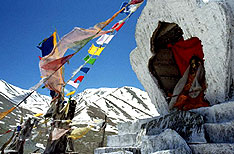 Lahaul and Spiti, the largest district in Himachal Pradesh, is a vast area of high mountains and narrow valleys bounded by Ladakh to the north, Tibet to the east, Kinnaur to the southeast and the Kullu valley to the south. Lahaul is often regarded as a midway point en route to Leh and the Indus valley, but has more to offer travellers. Spiti has only recently been opened to foreign tourists attracted to its isolated Buddhist gompas and villages. Lahaul is also a fascinating area for Buddhist art and culture. The monasteries of Lahaul and Spiti are rich repositories of ancient murals, thankas, wood carvings and golden images of the Padmasambhava. The people are charming, friendly and hospitable with their own traditional dances, ballads, folk tales and legends.
Lahaul and Spiti, the largest district in Himachal Pradesh, is a vast area of high mountains and narrow valleys bounded by Ladakh to the north, Tibet to the east, Kinnaur to the southeast and the Kullu valley to the south. Lahaul is often regarded as a midway point en route to Leh and the Indus valley, but has more to offer travellers. Spiti has only recently been opened to foreign tourists attracted to its isolated Buddhist gompas and villages. Lahaul is also a fascinating area for Buddhist art and culture. The monasteries of Lahaul and Spiti are rich repositories of ancient murals, thankas, wood carvings and golden images of the Padmasambhava. The people are charming, friendly and hospitable with their own traditional dances, ballads, folk tales and legends.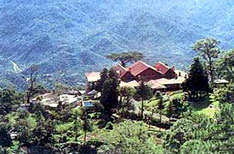 This small hill-station seems to live in a time warp that belongs to the l9th century. The narrow roads of Kasauli ( 1927 m) slither up and down the hillside and offer some magnificent vistas. Directly below is the spread of the vast plains of Punjab and Haryana which as darkness falls, unroll a gorgeous carpet of twinkling lights. At 3647 m, the peak of Choor Chandni (also called the Choordhar) powerfully dominates the lower hills and across the undulating ranges, Shimla is visible. The Upper and Lower Malls run through Kasauli's length. A mixed forest of pine, oak and huge horse-chestnut encircles the town. Its colonial ambience is reinforced by a stretch of cobbled road, quaint shops, gabled houses with charming facades and scores of neat little gardens and orchards.
This small hill-station seems to live in a time warp that belongs to the l9th century. The narrow roads of Kasauli ( 1927 m) slither up and down the hillside and offer some magnificent vistas. Directly below is the spread of the vast plains of Punjab and Haryana which as darkness falls, unroll a gorgeous carpet of twinkling lights. At 3647 m, the peak of Choor Chandni (also called the Choordhar) powerfully dominates the lower hills and across the undulating ranges, Shimla is visible. The Upper and Lower Malls run through Kasauli's length. A mixed forest of pine, oak and huge horse-chestnut encircles the town. Its colonial ambience is reinforced by a stretch of cobbled road, quaint shops, gabled houses with charming facades and scores of neat little gardens and orchards.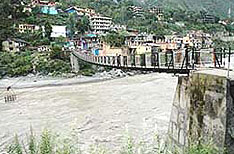 Rampur lies along the ancient trade routes to Tibet, Ladakh and Afghanistan. It used to be the capital of the mighty Bushahr Empire in the 18th century which had its borders well into Kinnaur. Today Rampur is one of Himachal?s most important market towns.
Rampur lies along the ancient trade routes to Tibet, Ladakh and Afghanistan. It used to be the capital of the mighty Bushahr Empire in the 18th century which had its borders well into Kinnaur. Today Rampur is one of Himachal?s most important market towns.